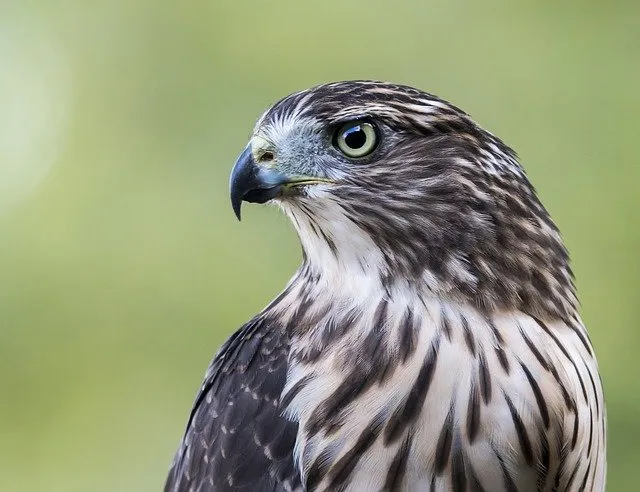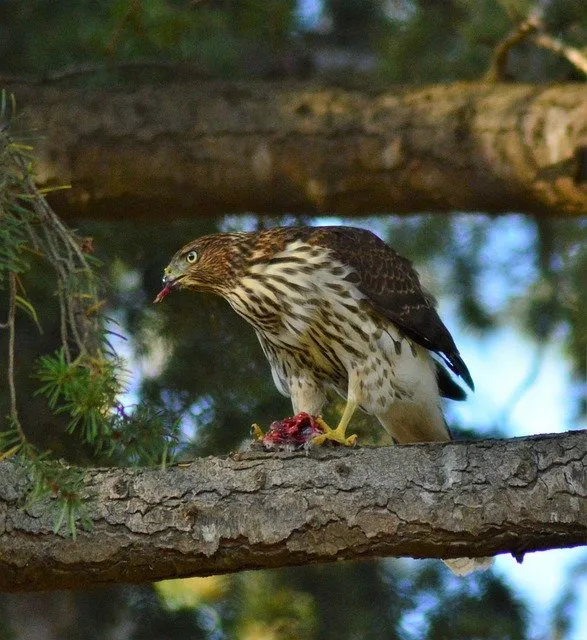As an Amazon Associate I earn from qualifying purchases.
The natural world is a treasure trove of marvels, where countless species roam and thrive in a delicate balance of survival and sustenance. Amidst this symphony of life, one creature stands out for its striking appearance, unparalleled hunting skills, and diet that reflects its prowess in the wild. So, what do Cooper Hawks eat? Enter the enigmatic Cooper’s Hawk (Accipiter cooperii), a predator renowned for its agility and aerial acrobatics.
Join us on an exhilarating journey as we unravel the mysteries of Cooper’s Hawk’s dining habits and explore the diverse array of delicacies that grace its menu. From high-flying pursuits to cunning tactics, let us delve into the captivating world of this avian predator and discover what culinary wonders lie within its grasp.
What Do Cooper Hawks Eat?
Nature’s intricate web of predator and prey is a captivating realm filled with fascinating species that rely on unique hunting strategies and dietary preferences. Cooper’s Hawks (Accipiter cooperii) have garnered significant attention among these magnificent creatures. Renowned for their agility and striking appearance, these raptors possess an appetite as remarkable as their prowess in the skies. Join us on a culinary adventure as we delve into the captivating world of Cooper’s Hawks and explore their diverse diet.
Birds:
Cooper’s Hawks are formidable avian hunters, capable of navigating dense forests with incredible speed and precision. One of their primary prey items is other birds, making them an apex predators in the avian kingdom. Their victims include smaller birds such as sparrows, finches, and thrushes, but they are also known to target larger species like pigeons and doves. With stealthy flights and sharp talons, Cooper’s Hawks seize their prey mid-air, utilizing their exceptional agility to outmaneuver their victims.
Small Mammals:
While birds dominate the menu, Cooper’s Hawks supplement their diet with small mammals. These include squirrels, chipmunks, and rabbits. Though mammals make up a smaller portion of their food intake, they provide a crucial source of nutrients for these raptors. Cooper’s Hawks rely on their keen eyesight and powerful wings to surprise their mammalian prey, often ambushing them from elevated perches or diving down to snatch them.
Reptiles and Amphibians:
Cooper’s Hawks exhibit impressive versatility when it comes to their diet. They showcase their hunting skills by preying on reptiles and amphibians as well. Snakes, lizards, and frogs find themselves at risk of becoming a delectable meal for these skillful hunters. The ability to adapt their feeding habits to different ecological niches reflects the resourcefulness and adaptability of these birds of prey.
Insects:
Despite their impressive stature, Cooper’s Hawks do not shy away from smaller prey items. Insects appear on their menu, especially during the breeding season when adults need to provide food for their chicks. The hawks feed on insects, including grasshoppers, dragonflies, and beetles. This dietary diversity ensures a continuous supply of sustenance throughout the year.
Occasional additions:
Cooper’s Hawks, like many predators, demonstrate opportunistic feeding behavior, taking advantage of available food sources in their environment. This means they may occasionally consume carrion or scavenge from carcasses left behind by other predators. These additional food sources provide the hawks an extra energy boost when their primary prey is scarce.
What Eats A Hawk?
While hawks are formidable hunters themselves, they are not exempt from becoming prey in the intricate web of nature’s food chain. Several predators are known to target hawks as a potential meal. Here are a few examples:
Larger Birds of Prey:
Hawks can fall victim to larger birds of prey, such as eagles and owls. These powerful predators may engage in territorial disputes or hunt smaller hawks to secure their territory or food resources.
Other Predators:
Hawks may face threats from other predators within their environment. Predators like coyotes, foxes, and bobcats are known to target hawks when given the opportunity. These terrestrial predators may prey on hawks nesting on the ground or resting in exposed areas.
Snakes:
Some species of snakes, such as large constrictors or venomous snakes, can threaten hawks. If a hawk encounters a snake while hunting or perching, it may become the snake’s prey if it fails to evade or overpower it.
Humans:
While not a natural predator of hawks, humans can inadvertently harm or kill hawks through activities like habitat destruction, pesticide use, or accidental collisions with vehicles and structures. However, it is essential to note that humans also play a significant role in conservation efforts to protect and preserve hawk populations.
How Does Cooper’s Hawk Help Our Ecosystem?
Cooper’s Hawks (Accipiter cooperii) play a crucial role in maintaining the balance and health of ecosystems in several ways:
Controlling Population of Prey Species:
As predators, Cooper’s Hawks help regulate the population of their prey species, particularly smaller birds and mammals. By preying on these animals, they prevent overpopulation, which can lead to ecological imbalances, such as habitat degradation and depletion of food resources. By controlling prey populations, Cooper’s Hawks contribute to the overall stability and health of the ecosystem.
Indicating Ecosystem Health:
Cooper’s Hawks are considered bioindicators, meaning their presence and behavior can provide valuable insights into the state of the environment. Since these hawks rely on healthy and intact habitats to thrive, their presence indicates the availability of suitable prey species and functioning ecosystems. Declines in Cooper’s Hawk populations may signify environmental disturbances or changes that require attention and conservation efforts.
Promoting Biodiversity:
By maintaining a balanced predator-prey relationship, Cooper’s Hawks indirectly promote biodiversity. Limiting the population size of certain prey species creates space and resources for other organisms to thrive. This, in turn, fosters a diverse range of species within the ecosystem, contributing to its overall resilience and stability.
Controlling Pests:
Cooper’s Hawks help control populations of rodents and other small mammals, which can be considered agricultural pests. By preying on these animals, the hawks provide a natural and eco-friendly method of pest control, reducing the need for chemical pesticides that can adversely affect the environment.
Educational and Ecotourism Value:
Cooper’s Hawks, with their graceful flight and striking appearance, captivate the interest of birdwatchers, photographers, and nature enthusiasts. Their presence in the ecosystem enhances natural areas’ recreational and educational value, fostering an appreciation for wildlife and promoting conservation efforts.
Final Words
In nature’s intricate balance, the Cooper’s Hawk emerges as a powerful predator, shaping ecosystems and captivating our fascination. From their awe-inspiring hunting skills to their role in maintaining population equilibrium, these raptors remind us of the interdependence that sustains life. By appreciating and safeguarding these magnificent birds, we embrace our responsibility to protect the delicate harmony of our natural world, ensuring a future where the Cooper’s Hawk continues to soar, symbolizing the resilience and beauty of our planet.
You can also read:
1.What Do Coyotes Eat?: A Dive into Their Eclectic Menu!
2.WHAT DO MAGPIES EAT? UNVEILING THEIR CULINARY PREFERENCES
3.A Gourmet Guide: What Do Aquarium Snails Eat?
4.What Do Basking Sharks Eat?: Unveiling Their Extraordinary Diet
Amazon and the Amazon logo are trademarks of Amazon.com, Inc, or its affiliates.



